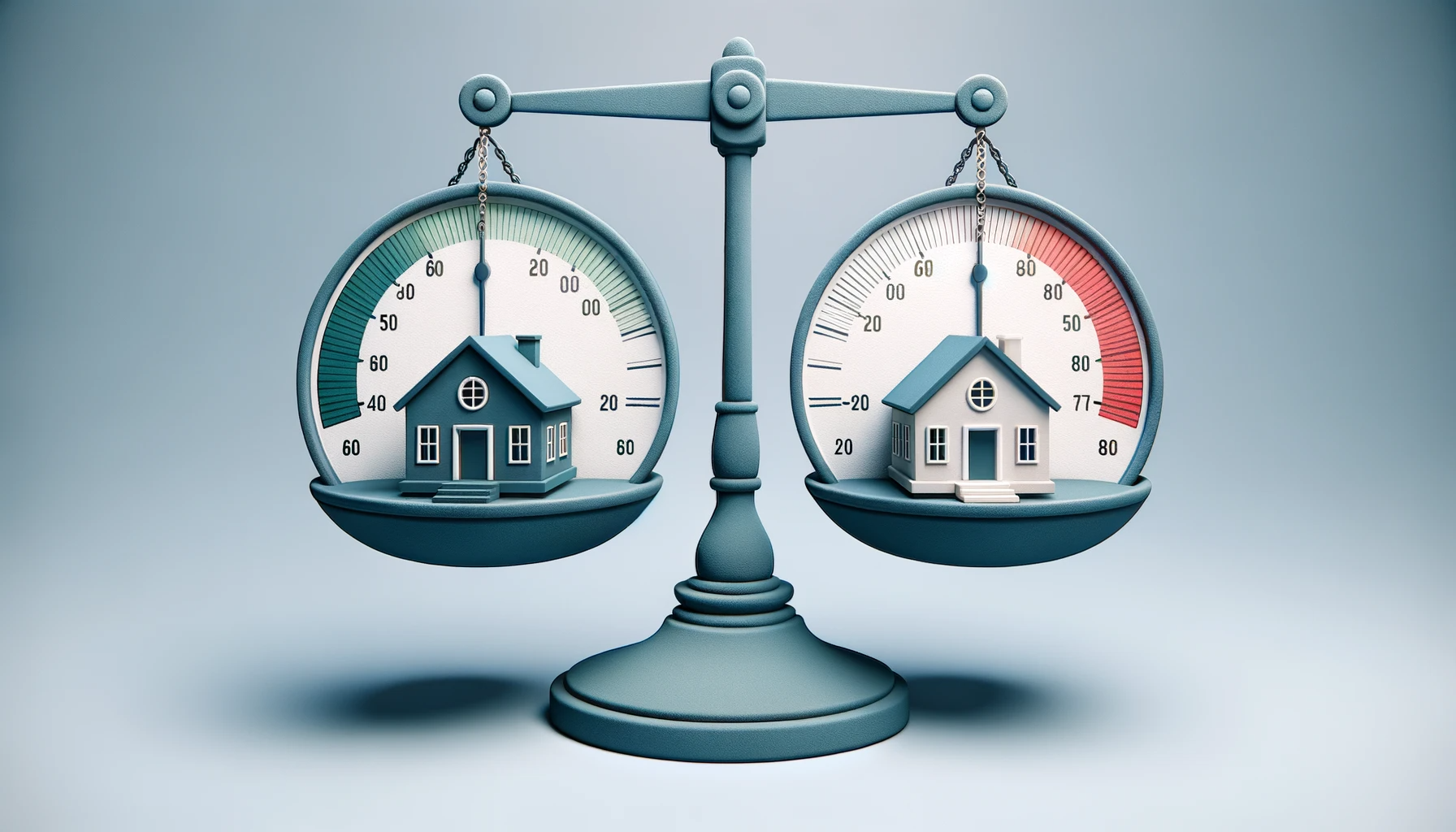What is APRC?
APRC stands for Annual Percentage Rate of Charge. It is a percentage figure that helps you understand the total cost of your mortgage over the entire term.
It combines all fees and interest rates into one number, making it easier for you to compare different mortgages, including secured loans.
As you explore mortgage options, you will generally encounter three crucial numbers:
- Initial Interest Rate. In fixed-rate mortgages, this rate indicates the interest you will be charged during the initial period, which generally lasts between 2 and 5 years. This rate is often lower than the standard variable rate (SVR) that comes later.
- Standard Variable Rate (SVR). After the initial period ends, your mortgage will likely shift to the SVR. This rate is usually higher than the initial rate and remains constant for the rest of the term unless you choose to remortgage.
- Fees. Securing a mortgage often involves several fees, including an arrangement fee which might be added to the total amount you borrow.
Understanding these numbers can be complex. That’s why consulting a mortgage broker can be a sensible choice, helping you select the right option based on your circumstances.
How is APRC Calculated?
To give you a clearer understanding, let’s consider an example.
Suppose you are planning to secure a 30-year repayment mortgage on a property valued at £200,000.
You have saved up a £30,000 deposit, which means you need a mortgage for £170,000. You are considering a 3-year fixed-rate mortgage.
Let’s evaluate two different mortgage options:
| Mortgage Type | Initial Interest Rate | Fees | SVR | Total Mortgage Cost | APRC |
|---|---|---|---|---|---|
| Mortgage X | 3.45% | £500 | 5.00% | £234,500 | 4.85% |
| Mortgage Y | 3.75% | £1,800 | 4.50% | £220,000 | 4.40% |
- Mortgage X starts with a 3.45% interest rate which later shifts to a 5.00% SVR. The arrangement fee here is £500.
- Mortgage Y has a higher initial rate of 3.75% but transitions to a lower SVR of 4.50%. The upfront fee for this option is £1,800.
At first, you might lean towards Mortgage X due to its lower initial interest rate and smaller fee. However, over 30 years, Mortgage X would end up costing you £234,500, whereas Mortgage Y would be less at £220,000.
This is where APRC comes in handy. It considers all fees and interest rates, giving you an idea of the total cost. In this case, Mortgage X has an APRC of 4.85%, and Mortgage Y offers a more favourable APRC of 4.40%.
What’s the Difference Between APRC and APR?
APRC and APR are both measures of the total cost of borrowing money, but they have some key differences.
APRC stands for Annual Percentage Rate of Charge, and it takes into account the interest rate, any fees, and the potential for changes in the interest rate.
APR, on the other hand, only considers the interest rate and fees at the time the loan is taken out.
APRC is more commonly used for mortgages than APR because it gives a more accurate picture of the total cost of borrowing over the lifetime of the mortgage.

What’s the Difference Between APRC and Interest Rates?
Interest rates are the percentage of the loan amount that the borrower pays to the lender each year. They can vary depending on the type of loan, the borrower’s credit score, and other factors.
APRC takes into account the interest rate, as well as any fees associated with the loan. This gives a more accurate picture of the total cost of borrowing.
In the case of mortgages, the interest rate can change over time. APRC takes this into account, while APR does not.

What’s the Difference Between APRC and AER?
APRC, or Annual Percentage Rate of Charge gives you a clearer picture of the loan’s true cost, which includes the interest rate along with any additional fees. Initially, you’ll be offered an introductory rate, which later shifts to a variable rate once the initial fixed period concludes.
Conversely, AER, which stands for Annual Equivalent Rate, is a term you’ll find when exploring savings accounts.
It predicts the growth of your savings over a year, considering aspects like compound interest and any special introductory rates that might be in place.
This rate assists you in comparing various savings options to find the one that suits you best.

Why Use APRC for Mortgages?
The Financial Conduct Authority (FCA) initiated the use of APRC in 2016 to foster transparency among borrowers regarding the total costs involved in a mortgage deal.
This step was taken to allow borrowers to have a clearer picture of all the potential charges and fees they might incur over the term of their mortgage, facilitating better and more informed decisions.
It’s important to note that a lower mortgage rate doesn’t necessarily translate to a better mortgage deal.
Apart from the rate, considering additional fees involved is pivotal to understanding the true cost of a mortgage.
Understanding Loans, Interest, and APRC
When you decide to take a secured loan or a mortgage, be prepared to pay interest on the borrowed amount. The rate of interest you’re charged is determined by a few crucial factors including:
- The amount you intend to borrow
- The period over which you plan to repay the loan
- Your specific circumstances, including your credit score
It’s important to note that the initial APRC mentioned in loan or mortgage ads, which might be 5% as an example, could change based on your credit history and circumstances, potentially increasing to something like 8%.
How to Get a Lower APRC?
APRC helps you compare different mortgage deals easily.
But, it’s important to know that this doesn’t tell the whole picture. When you apply, you might still get a different offer. This is because lenders look at several things about you, such as:
- Your Income. Lenders look at how much money you make each month to figure out how much you can afford to pay back.
- Your Expenses. Lenders also consider how much money you have left after paying your important bills each month.
- Your Credit Score. Keeping a good credit score is important. This score shows lenders how responsible you are with money. You can check your score with groups like Experian, Equifax, or TransUnion.
There are things you can do to get a lower APRC:
Boost Your Deposit
Putting down a bigger deposit means you borrow less money, which could give you a lower APRC. If you can manage a large deposit of around 40%, you might even get a lower interest rate compared to a small 5% deposit.
Choose a Shorter Mortgage Term
Picking a shorter time to pay back your mortgage can save you a lot on interest. But remember, this means you’ll have to make higher payments each month.
Improve Your Credit Score
A good credit score can show lenders that you’re a trustworthy person to lend money to, possibly giving you a better APRC.
And always remember this important advice:
Only borrow the amount of money you absolutely need, and aim to pay it back as quickly as you can.
Lastly, keep in mind that the APRC isn’t the only thing to think about when choosing a mortgage.
You should also consider the interest rate, the fees, and the overall terms of the deal.
Talking to a mortgage broker can be a smart move. They can help you find the best mortgage options for you and help you secure a deal with a lower APRC.
What Should You Keep in Mind When Applying for a Mortgage or Secured Loan?
When you’re in the process of securing a mortgage or a secured loan, it’s vital to consider a few critical aspects apart from just the APRC.
Let’s break down some of the important factors you should weigh:
Loan Duration
Consider the length of the mortgage or loan. A more extended period might offer the benefit of lower monthly payments. However, this usually means that you’ll end up paying more in the long run.
Overpayment Options
If you plan on paying more than the required monthly payment, you should investigate whether your mortgage provider allows for this without penalties.
Seeking a deal that offers this kind of flexibility can be a great advantage in the long term.
Potential Penalties
Always scrutinise the fine details of your mortgage agreement. It’s essential to know upfront if there are any charges for changing your mortgage plan or exiting it early. Being well-informed can help you avoid any unexpected costs down the line.
Flexibility
Lastly, assess the flexibility of the mortgage or secured loan.
For instance, consider whether it’s possible to transfer your mortgage to a new home if you decide to move. Opting for a plan that accommodates your future needs can give you peace of mind.
By giving attention to these factors, you can make a well-rounded decision that goes beyond just considering the APRC, aligning with your financial situation and future plans.
Key Takeaways
- APRC, or Annual Percentage Rate of Charge, shows you the total cost of a mortgage, including all fees and interest rates, as a single percentage.
- Mortgages typically offer an initial interest rate for the first few years, followed by a Standard Variable Rate (SVR), which is generally higher.
- APRC takes into account the potential fluctuation in interest rates over the lifetime of the mortgage, making it a more accurate tool for comparing mortgages than APR.
- To secure a lower APRC, focus on improving your credit score, increasing your deposit, and considering a shorter mortgage term.
- Consulting a mortgage broker can help you choose the right mortgage option for your personal circumstances.
The Bottom Line
Understanding the nuances of APRC rates can help you make informed decisions when exploring mortgage or secured loan options.
It allows you to gauge the actual cost over the entire term and compare various deals more straightforwardly.
Additionally, consulting with a good mortgage broker can be helpful.
They can provide clarity and personalisation, and help you find options that fit your financial situation and future plans.
A broker’s expertise can potentially help you secure a deal with a lower APRC, and simplify the complexities of choosing the right mortgage.
Ready to secure the best mortgage deal? Get in touch with us, and we’ll match you with experienced brokers who can guide you through the mortgage selection process.








